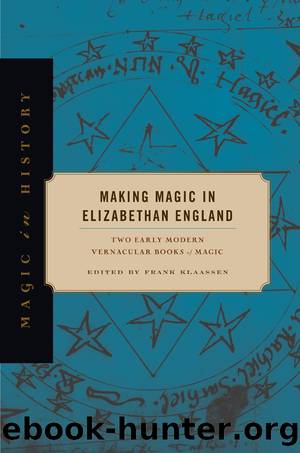Making Magic in Elizabethan England by Frank Klaassen

Author:Frank Klaassen
Language: eng
Format: epub
Publisher: Penn State University Press
The Boxgrove Manual
Introduction
Sometime in the late sixteenth century Owen Lording, the Protestant parish priest of Boxgrove, Sussex, commissioned a scribe to produce a copy of this manuscript. The scribe was less than accomplished and produced an artless manuscript in which the ink regularly bled through the paper and was sometimes splattered or smeared, making it difficult to read. Lording may well have been unhappy with the final product, and a conflict over whether he should pay for the manuscript might explain the somewhat officious note affixed to the first folio. This cites the local notary, George Stent, as a witness to the contract and gives the date Friday, February 13, 1600, 7 p.m. The original does not survive and the author is unknown, but since the author evidently employed the 1578 edition of Agrippaâs De occulta philosophia it was more than likely written in the last decades of the century.1 It was probably originally written in English, since there is no evidence that it was translated and it seems unlikely that the parish priest would have had the resources to engage a translator as well. The original author, who was probably not the scribe, drew on a variety of sources typical of sixteenth-century magicians: manuscripts and printed books, Renaissance magic and medieval magic. Like his forebears in the traditions of ritual magic he sought to discover and construct a true, good, and coherent practice of magic from sources that were not systematically unified. Also like them, the magic he made was an idiosyncratic synthesis.
The volume epitomizes the world of learned magic in Elizabethan England for a variety of reasons. In its pages we can see a well-versed enthusiast of medieval learned magic using the new materials on magic available in print. But it was not simply a process of reading and interpreting Henry Cornelius Agrippa, the most influential of the Renaissance magi, on whose De occulta philosophia he certainly drew. The writer was also clearly immersed in the older traditions of ritual magic and, because medieval sources were far less circumspect about providing specific how-to instructions, he employed them as the basis for his rituals. Very much like other contemporary magicians he read Agrippaâs encyclopedic and esoteric writings through the lens of practical works on magic, in this case two of the major works of medieval invocation magicâthe Thesaurus spirituum and Liber consecrationumâas well as the Liber quartus de occulta philosophia pseudonymously attributed to Agrippa (hereafter Liber quartus) and the Heptameron pseudonymously attributed to Peter of Abano.2 All the printed sources, and probably all the manuscript ones as well, were written in Latin and none of the printed works was released in translation until the mid-seventeenth century. So by writing in English the author made learned magic available to a wider reading audience, the priest of Boxgrove among them.
Download
This site does not store any files on its server. We only index and link to content provided by other sites. Please contact the content providers to delete copyright contents if any and email us, we'll remove relevant links or contents immediately.
| Africa | Americas |
| Arctic & Antarctica | Asia |
| Australia & Oceania | Europe |
| Middle East | Russia |
| United States | World |
| Ancient Civilizations | Military |
| Historical Study & Educational Resources |
Room 212 by Kate Stewart(4741)
The Crown by Robert Lacey(4574)
Endurance: Shackleton's Incredible Voyage by Alfred Lansing(4508)
The Iron Duke by The Iron Duke(4124)
The Rape of Nanking by Iris Chang(4024)
Killing England by Bill O'Reilly(3899)
Joan of Arc by Mary Gordon(3786)
Say Nothing by Patrick Radden Keefe(3726)
I'll Give You the Sun by Jandy Nelson(3274)
Shadow of Night by Deborah Harkness(3177)
Hitler's Monsters by Eric Kurlander(3165)
Mary, Queen of Scots, and the Murder of Lord Darnley by Alison Weir(3069)
Blood and Sand by Alex Von Tunzelmann(3060)
Darkest Hour by Anthony McCarten(3019)
Margaret Thatcher: The Autobiography by Thatcher Margaret(2972)
Eleanor & Park by Rainbow Rowell(2944)
Red Famine: Stalin's War on Ukraine by Anne Applebaum(2816)
Book of Life by Deborah Harkness(2721)
The One Memory of Flora Banks by Emily Barr(2686)
